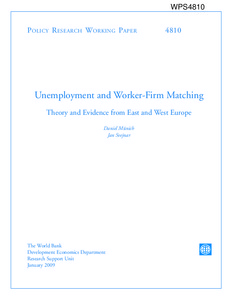Unemployment and worker-firm matching: theory and evidence from East and West Europe

World Bank - Washington, DC
2009
38 p.
Central Europe ; Eastern Europe
Policy Research Working Paper
4810
Unemployment
English
Bibliogr.
"The paper tests three hypotheses about the causes of unemployment in the Central-East European transition economies and in a benchmark market economy (Western part of Germany). The first hypothesis (H1) is that unemployment is caused by inefficient matching. Hypothesis 2 (H2) is that unemployment is caused by low demand. Hypothesis 3 (H3) is that restructuring is at work. Our estimates suggest that the west and east German parts of Germany, Czech Republic and Slovakia are consistent with H2 and H3. Hungary provides limited support to all three hypotheses. Poland is consistent with H1. The economies in question hence contain one broad group of countries and one or two special cases. The group comprises the Czech Republic, Hungary, Slovak Republic and (possibly) East Germany. These countries resemble West Germany in that they display increasing returns to scale in matching and unemployment appears to be driven by restructuring and low demand. The East German case is complex because of its major active labor market policies and a negative trend in efficiency in matching. In some sense, East Germany resembles more Poland, which in addition to restructuring and low demand for labor appears to suffer from a structural mismatch reflected in relatively low returns to scale in matching. Finally, our data provide evidence that goes counter to one of the main predictions of the theories of transition, namely that the turnover (inflow) rate in the transition countries would rise dramatically at the start of the transition, be temporarily very high and gradually decline and approach the level observed in otherwise similar market economies such as West Germany."
Digital
The ETUI is co-funded by the European Union. Views and opinions expressed are however those of the author(s) only and do not necessarily reflect those of the European Union or the ETUI.